Herzog & de Meuron

设计团队 赫尔佐格 & 德梅隆项目团队
项目地址 中国,香港,荷李活道10号
建造周期 2011-2018
场地面积 14,500平方米
撰文 雅克·赫尔佐格
前中区警署、中央裁判司署及域多利监狱旧址,是香港商业中心内的历史建筑群,由花岗岩墙体围合。该遗址由英国人于1841年建造,是英国在香港殖民时期的主警察局、地方法院和监狱,现今是香港最重要的历史建筑群之一。在2006年停止使用后,整个建筑群人去楼空,留下了一组露天场地和一系列独特的建筑。
The former Central Police Station, the Central Magistracy and the Victoria Prison is a walled compound of heritage buildings at the commercial centre of Hong Kong Island. Established by the British after 1841 as the colony’s main police station, magistracy, and prison, the site is one of Hong Kong’s most important remaining historic monuments. Following its decommission in 2006, the entire compound was vacated, leaving a set of open grounds and a collection of unique buildings.
从城市角度来看,在世界最密集的城市之一 ——香港的中心地段内,有这样一个带大庭院的建筑群实属罕见。它曾高居山坡之上,以全览的视角俯瞰港口,象征着法律和秩序的权威地位。如今,在商业和高层住宅所构筑的建筑森林中,它已然成为开放和平静的城市绿洲。该建筑群有两个大庭院:检阅广场和监狱操场,它们奠定了建筑群的空间结构。我们的目标是保持两者开放性和独特性的同时,重新激活空间,使其向城市公众开放。基于这两个庭院,整个场所将用于聚会休闲与文化交流等活动。
From an urban perspective, the compound is a rare "courtyard" in the middle of one of the densest cities in the world. What once stood on the hillside as a prominent symbol of law and order with commanding views to the harbour has now inversely become an urban oasis of openness and calm within a forest of commercial and residential high-rises. The compound is defined and structured by two large courtyards: the Parade Ground and the Prison Yard. Our goal is to preserve the openness and distinct character of both and to re-activate them for public use as a new type of urban found space. These spaces will define the site physically and programmatically as places of gathering, cultural exchange, leisure, and respite.

检阅广场四周被几处历史建筑包围,形成了一个边界明确的开放空间,为公共娱乐、活动赛事提供场地,从这里可以直接进入餐厅和零售点,还能举办小规模的文化和教育活动。先前的监狱操场令人生畏,但它将转变为新的开放式公共文化场所。
The Parade Ground is surrounded on each side by several of the site’s most historic buildings, resulting in a formal open space with generous room for public recreation, events, direct access to restaurant and retail attractions, as well as smaller-scale cultural and educational spaces. The Prison Yard will be subtly transformed from a rough and forbidding area to a new open public space dedicated to cultural programming.
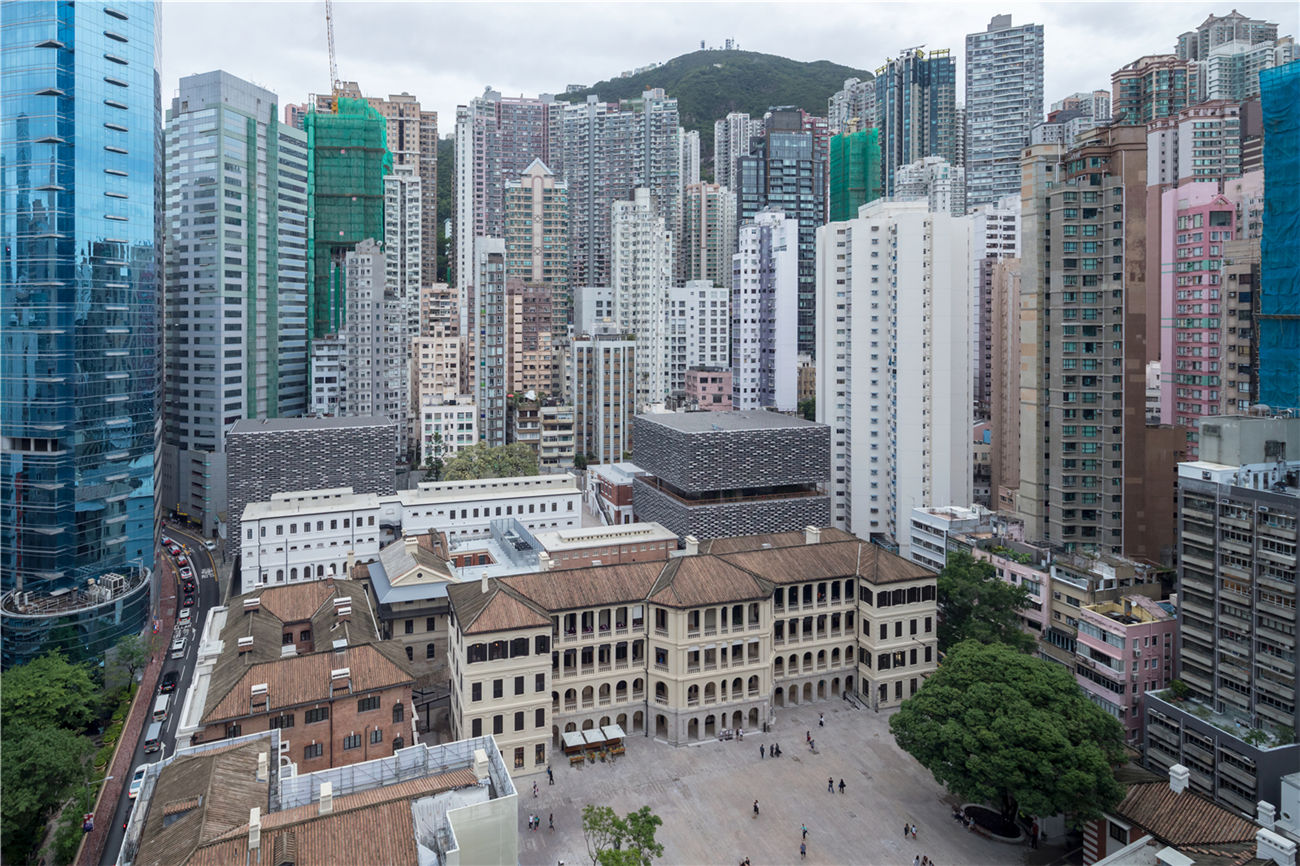
改造和激活遗址的关键策略之一,就是在建筑群中注入新的艺术文化活力。两个新的建筑体量悬挑于周围的花岗岩墙体上,对现有空间结构谨慎介入,但同时保有自身特色。“漂浮”的新建筑体量与相邻结构体维持最小距离,从而在可用区域范围内,将建筑面积最大化,同时通过偏移,创造了与周围历史建筑物间隔性的保护空间。
Adding a new arts and cultural program is one of the key strategies to opening up and activating the former Prison Yard. Two new volumes that float tightly above the surrounding granite walls are conceived as distinctive but carefully inserted elements within the fabric of existing buildings. By cantilevering above the walls and keeping a minimum distance to the adjacent structures, the buildable floor area is maximized while staying within the zoning envelope and at the same time creating protective offsets from the surrounding historical buildings.
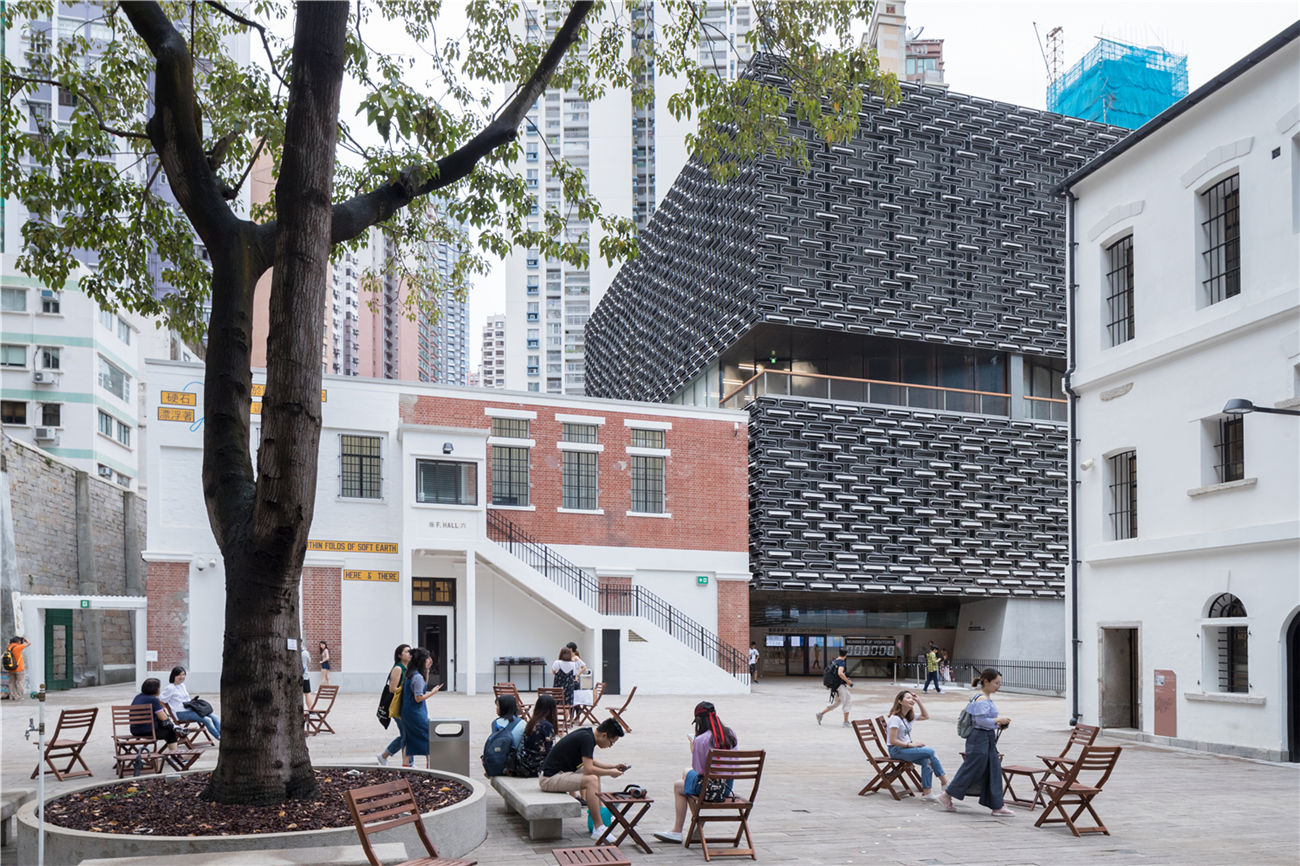

在建筑表达方面,新建筑与历史建筑被清楚地区分开来。在另一个标高较低的庭院中,前警署大楼建筑群集中于此,这些历史建筑物有的面街而立,有的在一层以花岗岩墙体为底座,彰显其权威性。另一方面,监狱建筑与外界以围墙相隔,一直以来它就与公共过道相分离,这也确保了监狱内外的安全性。但新建筑不能直接复制历史元素,而是通过将新建筑“悬浮”于墙体上方,从而构建与场地环境新的联系。
As an architectural expression, it also clearly distinguishes the new buildings from the site’ s historic buildings. Gathered mainly at the Lower Courtyard, the former police buildings sit proudly on either street level or on top of the granite walls, making their authority and presence in the city known. The prison buildings, on the other hand, are located behind the walls, and have historically been separated from public access and view for obvious reasons of safety and security. The new building volumes copy neither of the historical conditions but instead create a new relationship to the site context by hovering just above the wall.
新建筑通过设计地下层,提高空间容量后,公共空间与交通流通空间被放置在地下,从而为集会和各类活动提供宽敞且独立的场所,并建立了新的东西走廊,连接亚毕诺街与奥卑利街。与此同时,新建筑物位于整个历史遗址的两个端点,构成该地块的新标志,让人们关注这个此前封闭的城市一角。
By raising the volumes, new public and circulation spaces are created below, resulting in generous protected places for gathering and activity, and establishing a new East-West pedestrian connection from Arbuthnot Road to Old Bailey Street. At the same time, the buildings become new markers at the two ends of the compound, bringing attention to a formerly closed-off part of the city.
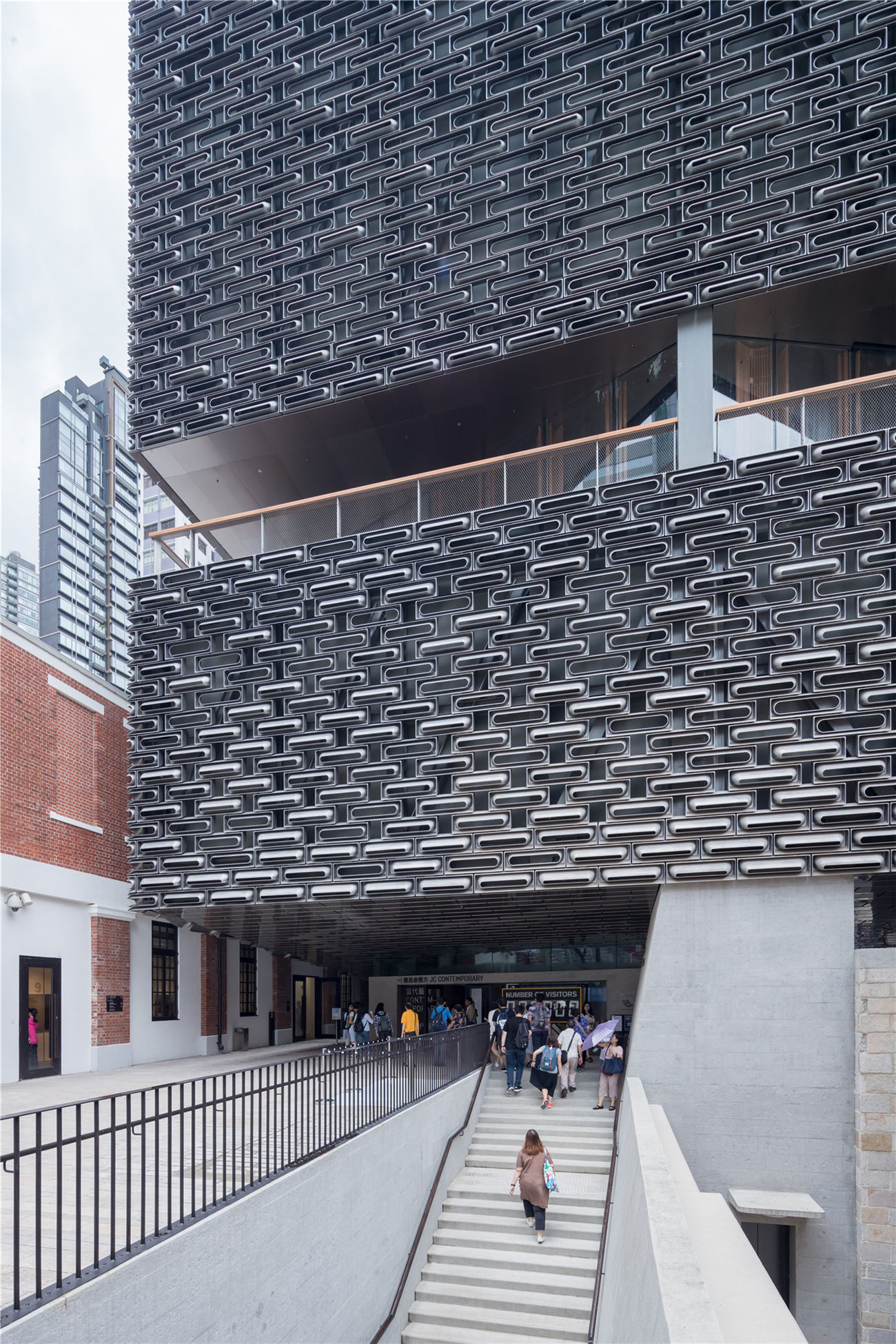
沿奥卑利街一侧的新建筑Old Bailey Wing,位于场地西南角,与适应性再利用的历史建筑F Hall联系紧密,二者的功能都与当代艺术相关。由于Old Bailey Wing悬挑于防护墙上方,得以留存空间设置入口庭院,此入口区域不受雨淋和日晒的影响,是F Hall和Old Bailey Wing的交通枢纽和门厅。多功能画廊F Hall将用于艺术展览或其他特殊活动,而岁月在原始建筑留下的痕迹都被保留了。与F Hall不同,相邻的Old Bailey Wing将拥有大型无柱展览空间,最大化其空间灵活性。屋顶的天窗将为顶部画廊空间提供自然采光。二楼是一家餐厅,设有户外露台,在这里可以俯瞰建筑群所根植的整个城市景观,它拥有着丰富的肌理与脉络。
The design of Old Bailey Wing, located at the southwest portion of the site, is developed in close relation to the adaptive reuse of the F Hall. New connections will be created between the two buildings. Together, they will house contemporary art functions. The courtyard entrance of the Old Bailey Wing is defined by the building’s volume hovering above the historic revetment wall. This entrance area is protected from rain and sun, and acts as the circulation hub and foyer to both the F Hall and Old Bailey Wing. The F Hall will be a versatile gallery space for art exhibition or other special events. Much of the original architecture with its traces from the buildings’ past use are kept and preserved.In contrast, the adjacent Old Bailey Wing will feature large column free exhibition spaces with maximum flexibility. Skylights in the roof will provide natural daylight into the top gallery space. The second floor is dedicated to a restaurant with an outdoor terrace overlooking the rich and textured roofscape of the entire compound embedded in the cityscape.
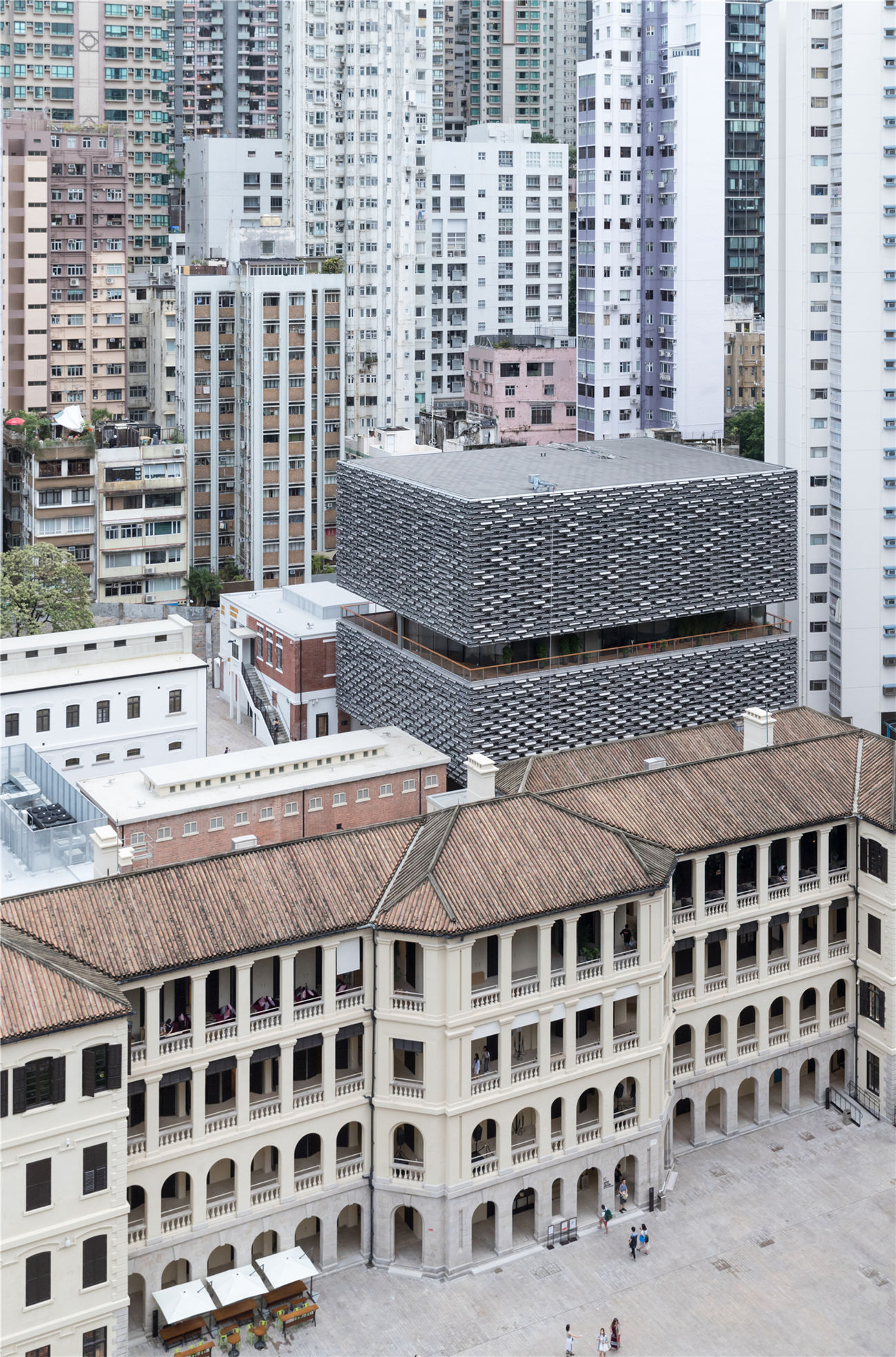
另一个新建筑Arbuthnot Wing是前中区警署遗址(the CPS site)东南角的新地标,是亚毕诺街新的临街建筑。该建筑同样“漂浮”在亚毕诺街的防护墙上方,创造了一个有顶的室外公共聚会、电影放映和表演空间,内部的大楼梯可以随意落座让游客轻松享受各类文娱活动。
Sitting as a new marker on the southeast corner of the CPS site is the new Arbuthnot Wing. The volume similarly hovers above the revetment wall along Arbuthnot Road, creating a covered public outdoor gathering, cinema and performance space with a large stair whose steps may be used for informal seating.
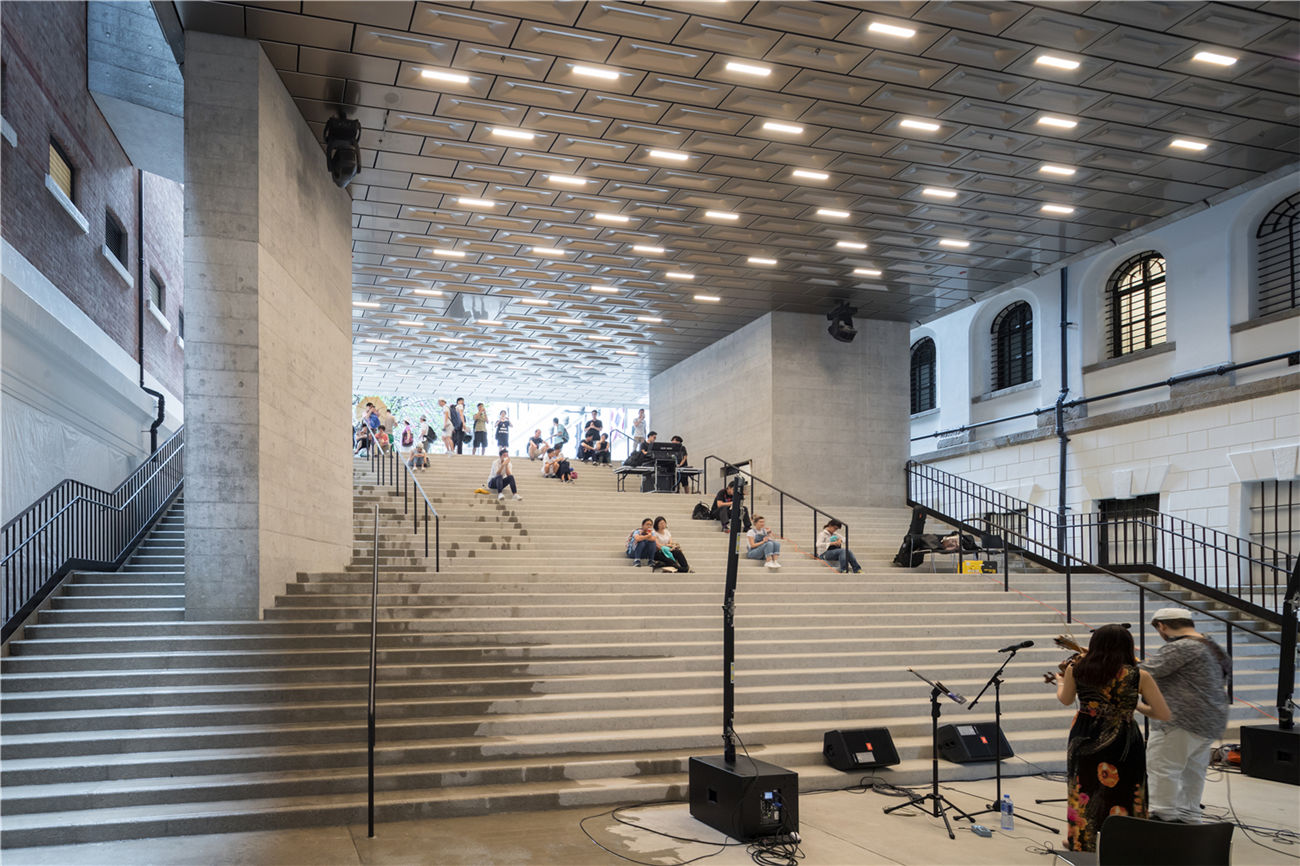
沿亚毕诺街的两侧是旧监狱建筑——D Hall和E Hall,为这个独特的户外场地构筑了沿街立面。室内高度被充分利用,产生了两个宽敞的空间:一个8米高的多功能厅,配以无障碍技术的网格天花板;一个机械厂房,里面有冷却塔和设备,服务于整个场地。
On either side of the Arbuthnot Wing are old prison buildings, D Hall and E Hall, forming interior elevations for this unique outdoor venue. The height restriction is also fully taken advantage of, resulting in two more generous program spaces above: an 8m height multipurpose space with an accessible technical grid ceiling, and a mechanical plant room that houses cooling towers and equipment serving the entire site.
两座新建筑Arbuthnot Wing与Old Bailey Wing均采用铝铸外墙模数系统,在尺度和比例方面,呼应了遗址的特色边界——防护墙现有的花岗岩砌块元素,从而建立了一定的文脉关系。材料采用100%再生铝,使建筑外观独特且具有质感。新建筑物成为历史砖石建筑群中的新介入物,解决了自身结构支撑的同时,还具备遮阳和在香港亚热带气候下防雨的功能。立面单元间的特殊孔隙、构筑的图案和风貌,是受其内部功能和环境影响的。铝铸材料单元具有独特的粗糙度和纹理,打破了规整单调的外立面形象,且有助于降低白天光照的反射率和眩光。到了晚上,建筑物发出的光将被外墙的模数单元部分屏蔽,在呈现其内部活动的生动状态时,还不会产生光污染。
Both new buildings are clad with a cast aluminium façade unit system that is referencing, in terms of scale and proportion, the existing granite block elements of the characteristic bordering revetment wall surrounding the entire site, thus establishing a certain contextual relationship. The use of 100% recycled aluminium as a material provides a distinctive architectural expression and materiality, setting the new buildings apart as new insertions amongst the collection of historical masonry blocks, and at the same time addresses issues such as structural support, sun shading, and rain protection in Hong Kong’s subtropical climate. The specific porosity, patterning, and expression of the façade unit is informed by the functional and environmental requirements of the uses within. The materiality of the cast aluminium units will have a distinctive roughness and texture breaking down the façade surface, which helps to reduce the reflectivity and glare during the daytime. At night, light emitted from the building will be partially screened by the façade units, expressing the life of activities within but without creating light pollution.

“在香港,我们所做的是将前中区警署遗址改造成文化中心。无论是在香港还是在中国大陆,这仍然是一种全新的建筑改造方式,是一件不寻常的事情。因为在通常情况下,旧建筑和整个社区都会被拆除,而后被新建筑取代,通常对现有基地条件没有什么想法(TABULA RASA)的建筑师会这么做。对我们来说,在西方也是如此,直到不久之前情况才有所转变。现代主义到来以后,此前遗留之物看起来陈旧也跟不上时代。在日常生活中,我们仍然在不经意间,倾向于舍弃那些每日使用的东西,而没有循环利用并以适当甚至创造性的方式重新整合它们。在20世纪70年代,当我们开始有所实践时,我们首先要找到并建立自己的建筑语言,让已有的想法和事物再演化、再利用——并不一定来源于过往的辉煌成果,而只是那些于我们面前所见的便足以;早年间的项目中,这种方式已经转化为基本元素融入建筑语言中。想起早期项目如“巴塞尔广场”“塔沃尔石屋”,以及后来的“泰特现代美术馆”或是现在的“大馆”,我们采取了“融合”的策略,而不与现存物质世界“对抗”,因为我们发现此方式下场所是有生机的,通常会产生意想不到的创新性结果。
“What we have done in Hong Kong is to transform a former Police Station into a Cultural Centre. In Hong Kong and also in Mainland China this is still a totally new approach to architecture - an unusual thing to do because normally old buildings and entire neighbourhoods are being removed and being replaced by new ones. The principle is TABULA RASA. For us architects, also in the West, it was quite similar until not so long ago. Modernism was making pre-existing things look old, shabby and uncool. In daily life we all still carelessly throw away things we use every day instead of recycling and reintegrating them in a somewhat appropriate or even creative way. In the 1970s, when we started our practice, we first had to find and define our own architectural language. Re-Inventing and Re-Using pre-existing ideas and objects – not necessarily of a heroic period of the past, but simply of what we found in front of us – has become an essential element within our vocabulary since those early days and projects...think of early projects such as the ‘Marktplatz Basel’, ‘Stone House Tavole’, later of course ‘Tate Modern’ or now ‘Tai Kwun’. We adopted this strategy of working WITH instead of AGAINST the existing material world of objects because we found it natural and inspiring, often resulting in unexpected and innovative results.
从根本而言,无论是在巴塞尔还是在伦敦,利古里亚或是香港,其处理方式都没有区别。”
There is no fundamental difference for such an approach, whether you do it in Basel or in London, in Liguria or in Hong Kong.”

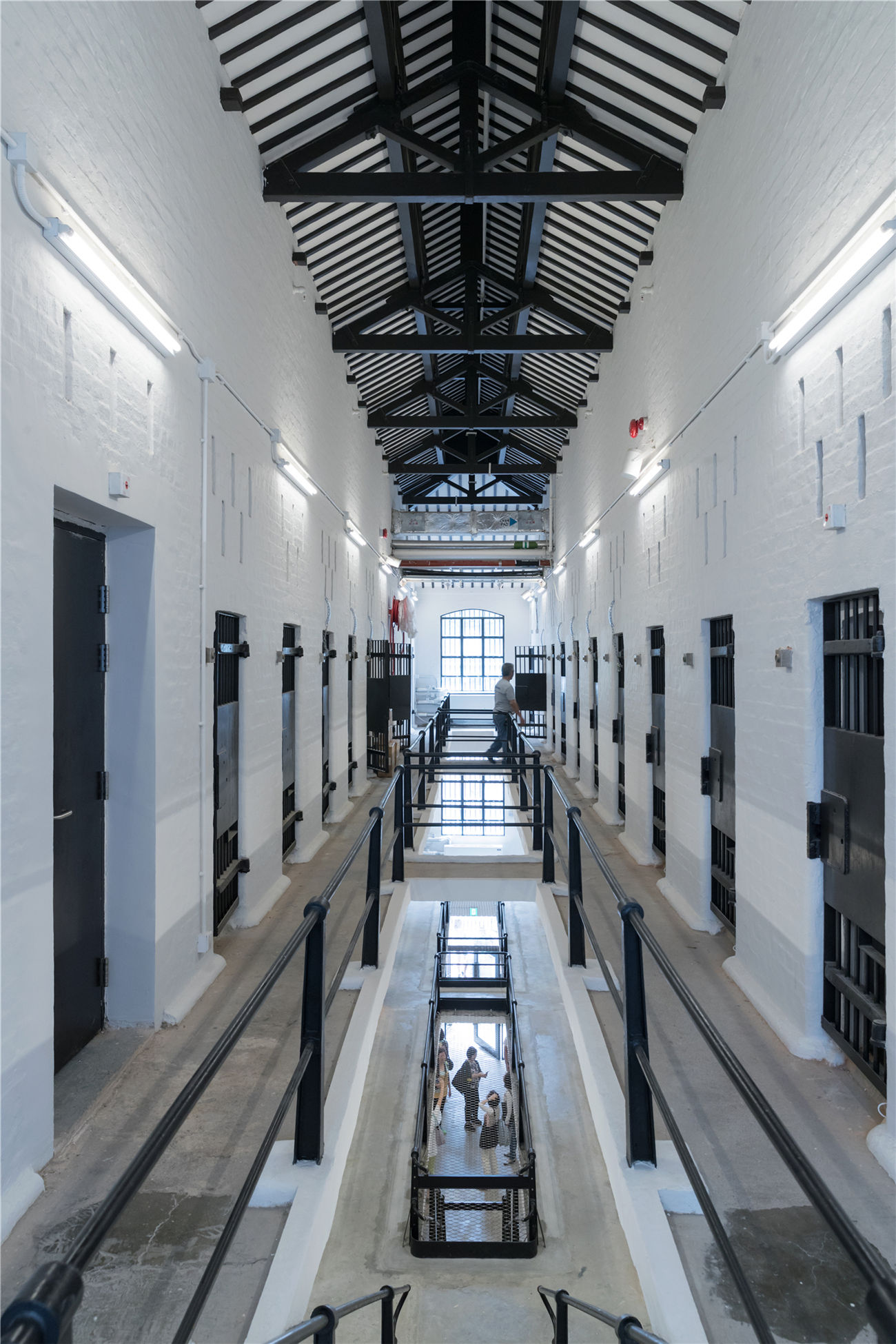
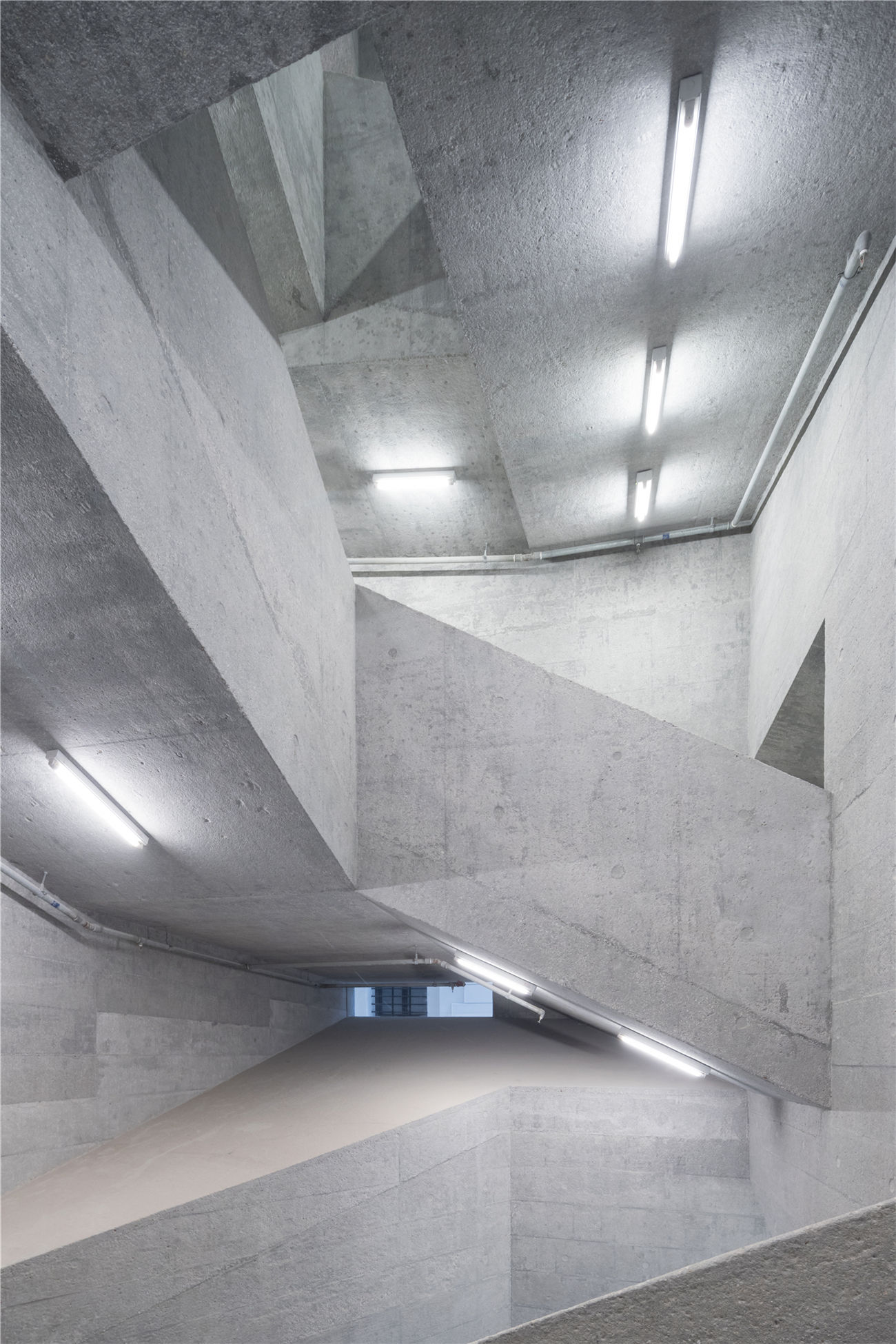
完整项目信息
PROJECT KEY DATA
Project Name: Tai Kwun, Centre for Heritage & Art
Location: 10 Hollywood Road, Hong Kong, China
Project Phases: 2006-2012
Realization Phases: 2011-2018
Client: The Hong Kong Jockey Club, Hong Kong
Client Representative: John Latter (Head of Property Project Management), Timothy Calnin (Director of Tai Kwun)
Project Team: Herzog & de Meuron Project Team
BUILDING DATA
Site Area: 14,500 m²
Gross Floor Area (GFA): 27,000 m²
Number of Levels: 24
Footprint: 10,500 m²
Length: 140 m
Width: 110 m
Height: 50 m
DETAILED DATA
Open Courtyard Area: 4,000 m²
Old Bailey Wing: foot print: 800 m²; floor area: 4,100 m²; dimensions: 33 m (L) x 25 m (W) x 26 m (H); building envelope area: 4,200 m² (including soffit & roof)
Arbuthnot Wing: foot print 550 m²; floor area 3,100 m²; dimensions 32 m (L) x 20 m (W) x 31 m (H); building envelope area 3,300 m² (including soffit & roof)
版权声明:本文由Herzog & de Meuron建筑事务所授权发布,禁止以有方编辑后版本转载。
投稿邮箱:media@archiposition.com
上一篇:两个长舱:图解棉仓城市客厅改造 / 阿科米星
下一篇:建筑实验室:创盟国际海外个展在柏林开幕